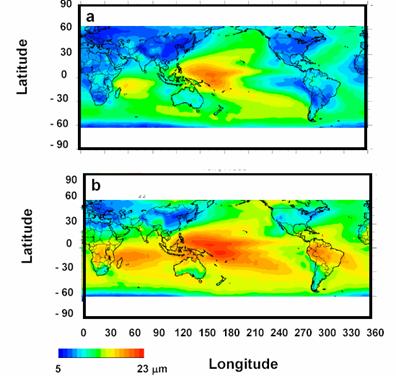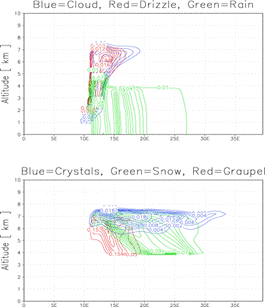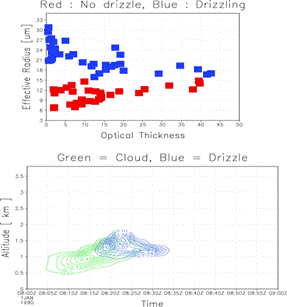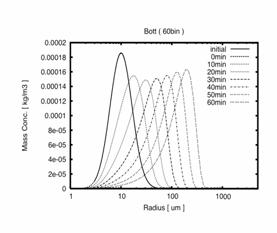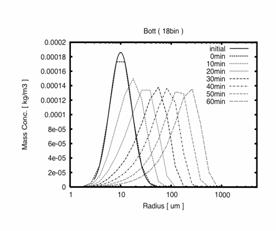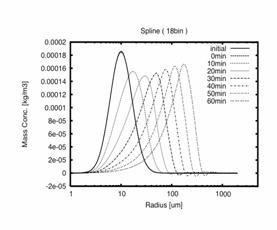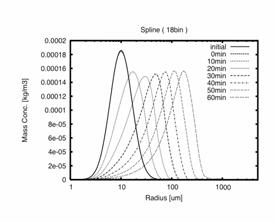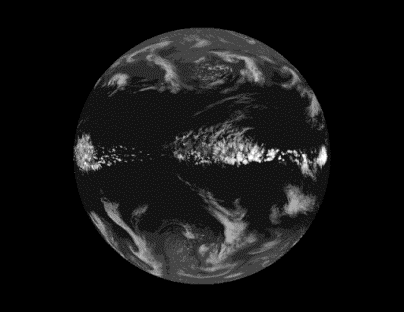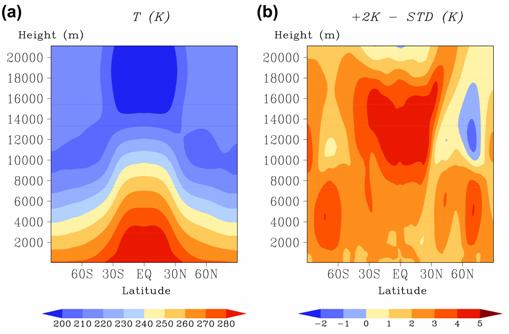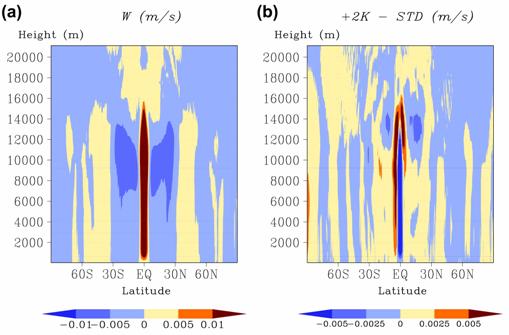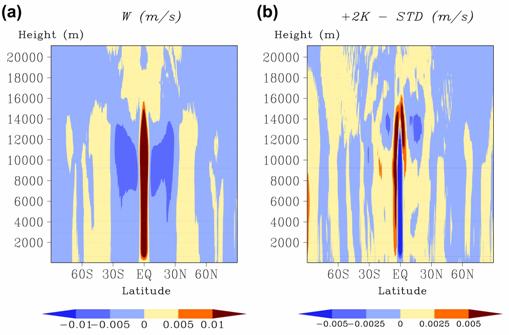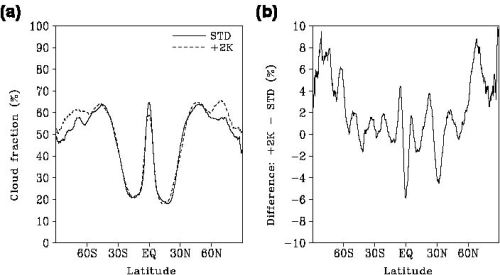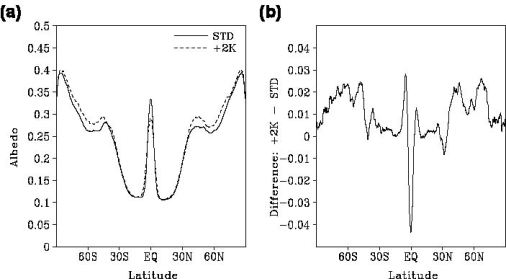2. Warming and atmospheric composition change interaction model developmentResults Page | Top Page | |||||||||||||||||||||||||||||||||||||||||||||||||||||||||||||||||||||||||||||||||||||||||||||
|
2-2 A warming-cloud, aerosol, and radiation feedback precision evaluation The organization in charge: Earth environment frontier research center
a. SummaryThis group's subject is developing parameterization for a general circulation model (GCM) estimating the indirect radiation legal force of the influence aerosol affects the optical characteristic of clouds, i.e., troposhere aerosol. parameterization which evaluates the influence the condensation nucleus (Cloud Condensation Nuclei:CCN) of a cloud particle already affects the fine structure of clouds is developed. This parameterization was taken into CCSR/NIES/FRCGC-AGCM with SPRINTARS which is an aerosol climate model, and global distribution of the optical thickness of clouds or a cloud particle effective radius was calculated, and it inquired by performing comparison with satellite observational data. Furthermore, development of the cloud resolving domain model which carries the bottle method detailed cloud physics model is also performed using cloud resolving domain model CReSS (Tsuboki and Sakakibara, 2002). In this subject of research, in order to evaluate the climate influence of the interaction of clouds and aerosol, development of the numerical model which can express the fine physics process of aerosol transportation and clouds in detail on a scale of global is also performed. In Center for Climate System Research, University of Tokyo, when the non-statics bottle method detailed cloud physics model was developed and a numerical simulation was done, being obtained by the past satellite observation about the optical characteristic of clouds and the similar feature were reproduced. Moreover, in order to enable calculation of detailed cloud physics process in which calculation cost was saved, the method of developing and forecasting a particle-size-distribution function with a basis function was formulized. As a result, it was suggested that it is calculable with sufficient accuracy also with little flexibility compared with the conventional method. Furthermore, the work which mounts aerosol chemistry transportation model SPRINTARS in global non-statics models NICAM was started. On the other hand, the basis of a water planet setup which is one of the basic experiments, and the climate sensitivity experiment were conducted for verification of the performance as a climate model of NICAM. b. Research purposeb.1. Development of parameterization for GCM using a detailed detailed cloud physics model The main factors of uncertainty with the still large estimate of the indirect radiation legal force of troposhere aerosol are because aerosol and the relation of clouds are indefinite. Although it works as CCN in aerosol, the particle size distribution of a cloud particle is decided by particle size distribution, chemical composition, and upward flow speed in clouds, the efficiency of precipitation, such as the optical characteristics, such as reflectance of clouds and optical thickness, and the rain ease of coming down, changes, as a result it is effective against radiation balance or a water cycle in climate change prediction. Such causal relationship is clarified and parameterization for evaluating the aerosol indirect radiation legal force for GCM is developed. b.2. global climate modeling of an aerosol-detailed cloud physics interaction In order for the accuracy which can trust the radiation legal force by the large aerosol indirect effect of uncertainty when understanding and predicting a climate change to estimate, he needs to understand quantitatively the influence aerosol affects the optical characteristic and the precipitation characteristic of clouds. The actual condition of such an interaction of aerosol and clouds has effective numerical modeling, in order to interpret those observational data quantitatively and to understand the impact to the climate of an aerosol - cloud interaction in detail, although it is becoming clear on a scale of all balls in observation with satellite observation in recent years. So, it aims at development of the numerical model which can express aerosol transportation and the interaction of cloud physics process in detail on a scale of global in this subject of research. c. A research program, a method, schedulingc.1. Development of parameterization for GCM using a detailed detailed cloud physics model In this symbiosis project, parameterization for a general circulation model (GCM) with unreal carrying a detailed cloud model to estimate the influence aerosol affects the optical characteristic of clouds is developed. parameterization developed here is taken into CCSR/NIES AGCM with SPRINTARS which is an aerosol climate model, and global distribution of the optical thickness of clouds or a cloud particle effective radius is calculated, and it inquires by performing comparison with satellite observational data. Furthermore, in order to make it the effective thing as parameterization for GCM, development of all the ball models that carry the bottle method detailed cloud physics model, and a cloud resolving domain model is performed. All the ball models NICAM and the 2 moment bottle method detailed cloud physics model to cloud resolving domain model CRESS will be carried FY 2004, comparative experiments will be conducted from FY 2005, and parameterization for GCM will be developed henceforth. c.2. global climate modeling of an aerosol-detailed cloud physics interaction In this subject of research, in order to investigate quantitatively first the influence aerosol affects the particle size distribution of clouds, and the optical characteristic and the precipitation generation characteristic, the bottle method cloud model which can express the fine physics process of clouds in detail is developed, and a numerical simulation using it is done. Furthermore, the interaction of a cloud system also including a convective cloud and aerosol transportation is calculated on a scale of global by mounting aerosol transportation model SPRINTARS on it, using global non-statics models NICAM as a dynamics platform. Moreover, in order to solve the problem of the calculation cost which the bottle method cloud model holds and to enable calculation of the detailed cloud physics process in a wide area and global, the calculation method based on basis-function deployment of particle size distribution is formulized, and a numerical simulation for utilization is done. A numerical simulation which used development and it of the bottle method cloud model is done, and the mounting work to NICAM of SPRINTARS will be done in FY 2004. Moreover, a basis-function unfolding technique is formulized. In FY 2005, the initial experiment of a SPRINTARS-NICAM joint model and tuning are performed, and combination with a detailed cloud physics model (the bottle method and basis-function method) will be performed. The integrative simulation in all the ball scales of a cloud - aerosol interaction is performed after FY 2006. d. The research program in FY 2004d.1. Development of parameterization for GCM using a detailed detailed cloud physics model parameterization (Kuba et.al, 2003, Kuba and Iwabuchi, 2003, Kuba, 2005) which was developed by the detailed cloud physics model (Kuba et al., 2003) developed by the earth frontier research system and which evaluates the influence CCN affects the fine structure of clouds was taken into CCSR/NIE/FRCGC-AGCM with SPRINTARS which is an aerosol climate model, and global distribution of the optical thickness of clouds or a cloud particle effective radius was calculated, and it inquired by performing comparison with satellite observational data. Furthermore, in order to make parameterization for GCM effective, the 2 moment bottle method detailed cloud physics model is carried in the 3-dimensional non-statics model CReSS. In this case, the method of expressing with gamma distribution the initial cloud particle particle size distribution of the bottle method which combined the above-mentioned cloud particle number density with parameterization for which it asks from CCN number density and the upward flow in a cloud, and developed it in the last fiscal year is used. Moreover, a detailed cloud physics model loading super-high resolution global model is developed using NICAM (New Icosahediral Atmospheric Model, Satoh, 2003, Tomita, 2002). d.2. global climate modeling of an aerosol-detailed cloud physics interaction The non-statics bottle method detailed cloud physics resolving model which can express the precipitation process of a system in which aerosol, the quality of a matter of chance, and a ice grain child live together is developed. Furthermore, a numerical simulation for investigating the influence aerosol affects the optical characteristic and the precipitation characteristic of a water cloud using the developed model is done. Moreover, the numerical orientation method which develops and forecasts the particle size distribution of a condensation product with a basis function as a trial for calculating the fine physics process of clouds at low calculation cost is formulized. Furthermore, from the second half of a fiscal year, the work which mounts global aerosol chemistry transportation model SPRINTARS(s) developed by global non-statics models NICAM developed in the earth environment frontier research center at Center for Climate System Research, University of Tokyo and the Kyushu University applied mechanics research institute as preparation for developing the model which can treat an aerosol - cloud interaction on a scale of global is started. e. Fruits of work in FY 2004e.1. Development of parameterization for GCM using a detailed detailed cloud physics model It is an aerosol transportation model about what extended the approximate expression which asks for the cloud particle number density developed by FY 2003 (Kuba et.al, 2003, Kuba and Iwabuchi, 2003, Kuba, 2005). It tried to take in to CCSR/NIES/FRCGC-AGCM which carries SPRINTARS. This approximate expression predicts cloud particle number density from the ascending current velocity the tale of cloud nucleus which is activated with each degree of supersaturation of the aerosol in the atmosphere (0. 2, 0.4, 0.5, 1.0, 2.0 %) and in which it deals, and near a cloud base, and is drawn from the result of much numerical simulations by a detailed cloud physics model. Artificial origin aerosol is effective in taking into consideration the effect given to climate changes, such as global warming. Since SPRINTARS outputs all ball distribution of the mass of sea salt particles, sulfuric acid particles, organic carbon particles, a black carbon grain child, and a soil particle, it is necessary to assume particle size distribution to each particle, and to get to know the minimum dryness radius of the particles which can become a cloud particle with each degree of supersaturation of (0.2, 0.4, 0.5, 1.0, 2.0 %). Sea salt particles are sodium chloride as a typical substance. About NaCl, they are sulfuric acid particles. Ammonium sulfate (NH4) 2shift out4 is assumed. To these substances, since physical properties are clear, calculation of equilibrium vapor pressure is possible, and easily, the relation between the degree of supersaturation and a dryness radius can be found, as shown in Table 6. About black carbon and a soil particle, since it is hard to become cloud nucleus if independent, since it is lacking in hygroscopicity in itself, it does not take into consideration at a present stage. Moreover, it is not desirable to ignore, since organic carbon particles understand a certain thing also for what functions enough as cloud nucleus by investigation so far. However, since many substances are contained in organic carbon, it is difficult to inquire separately, respectively. Then, the dryness radius was calculated for the density and hygroscocipity which are raised to Ghan et al. (2001) as average character of organic carbon to reference. They are also expressed to Table 6. Table 6: Relation of minimum dryness radius which can be activated with degree of supersaturation and can become cloud particle
Moreover, the 100km of the number of CCSR/NIES/FRCGC-AGCM, with grid spacing, since the upward flow in clouds is unresolvable, Lohmann et al. (1999) is imitated. Upward flow speed was computed using turbulent kinetic energy. Thus, annual average global distribution of the cloud particle effective radius of the cloud top more than temperature 273 K in 2000 for which it asked is figure 42a. The contrast of the land and sea obtained by satellite observation is reproduced, and the value has also agreed with observational data in general. Although it was treatment of making it a bundle, about organic carbon, if organic carbon particles are disregarded and same calculation is carried out only by sea salt particles and sulfuric acid particles, it will become like figure 42b and observational data will bring the result of having applied and separated. From this, though it was inadequate, as for contribution of organic carbon, it was desirable to have taken in, and it was able to be shown here that introduction of this approximate expression is effective in assessment of warming feedback of aerosol at global models. However, since the cloud particle effective radius is more smallish somewhat on the continent if it compares with satellite observational data finely, it is necessary to consider further the handling of how to estimate upward flow or organic carbon particles. It is possible to combine with this parameterization that approximates cloud particle number density from CCN number density and upward flow speed, and the method of approximating cloud particle particle size distribution by gamma distribution, and to consider it as the initial cloud particle particle size distribution of the bottle method detailed cloud physics. The work which carries this initial cloud particle particle size distribution and the 2 moment bottle method detailed cloud physics model in a 3-dimensional non-statics model is done. Improvement of parameterization, such as an effect of CCN exerted on improvement of how to take out the upward flow of global models and precipitation formation by this 2 moment bottle method detailed cloud physics model 3-dimensional loading non-statics model, is measured.
Fig. 42: SPRINTARS was carried. Annual average of the cloud particle effective radius of temperature 273K or more cloud tops in 2000 which introduced and calculated the approximate expression (Kuba et.al, 2003, Kuba and Iwabuchi, 2003, Kuba, 2005) which predicts cloud particle number density to CCSR/NIES/FRCGC-AGCM e.2. global climate modeling of an aerosol-detailed cloud physics interaction e.2.1. The transplant to the development of a detailed cloud physics model and NICAM of the aerosol model CHASER using a basis-function method First, in Center for Climate System Research, University of Tokyo, the non-statics bottle method cloud model which can express the fine physics process of a system in which aerosol, and water and a ice grain child live together was developed (Suzuki and 2004). This is the model which the bottle method detailed cloud physics model for calculating the spatial distribution and time development of the non-statics frame for expressing explicitly the convection which plays a role important for cloud generation, and a particle system (aerosol, water, and ice) combined. In the portion of the bottle method cloud model, change of the particle-size-distribution function by various fine physics process about each of aerosol, water particles, and a ice grain child is forecast explicitly. While aerosol serves as cloud nucleus, a cloud particle is more specifically generated and it grows up to be precipitation particles through condensation growth, a collision, and a coalescence process, in the domain of zero or less temperature, signs that these water particles freeze, generate needle ice, and hail and snow are generated by a collision and annexation of water particles, needle ice, and needle ice are calculated in detail. By combining with a non-statics frame and performing such calculation, generation of warm rain and cold rain is calculable (Fig. 43). A numerical simulation which generates the water cloud of few stories using such a model was done, and analysis which paid its attention to the optical characteristic of clouds was conducted. From the conventional satellite observation (Nakajima and Nakajima, 1995), the correlation pattern between the optical thickness of clouds and an effective particle radius changes systematically with developmental stages of clouds, and it is reported by the growth stage before rain generation to both being in positive correlation on the growth stage accompanied by rain that both are in negative correlation. Then, when correlation of optical thickness and an effective particle radius was investigated from the calculation result of a model, the above conventional observation results and a similar correlation pattern were reproduced (Fig. 44). When extending such a detailed bottle method detailed cloud physics model to a
broader-based simulation, calculation cost often became a problem, but in
this research, the basis-function unfolding technique was formulized as a
trial for performing the simulation of particle size distribution at low
cost. With this method, it の -- it develops like, and the prognostic equation of a combination coefficient cj is drawn and calculated from conditions for this expression to carry out the best approximation of the differential equation which the particle-size-distribution function of a basis should fill. Although various things as a basis function may be adopted, the result of having used the B-Spline basis function here is shown. Fig. 45 shows the situation of time development of the particle size distribution by a collision and a coalescence process. by the method of Bott (1998) which is the scheme of the Bin method used widely now, when the number of bottles is reduced to 18 bottles compared with the case where 60 bottles are prepared, numerical diffusion sees -- having (especially after 60 minutes) -- numerical diffusion is controlled when it develops with a B-Spline function. This is considered to be because it to be the function system designed so that the bent of the curve inside a bottle might be expressed while a Spline function guarantees the continuity of the function value and differential value in a bottle boundary. However, since a negative non-physics value may arise in Spline deployment as shown also in Fig. 45, compensation of distributing a value to a surrounding bottle in that case is performed. What kind of correction method is the optimal is the subject which should be examined in the future. Furthermore, in this subject of research, the work which mounts aerosol chemistry transportation model SPRINTARS (Takemura et al., 2000, 2002) in global non-statics models NICAM (Satoh, 2002, 2003; Tomita et al., 2002, 2004) for the reappearance experiment of the cloud - aerosol interaction in global scales was started. SPRINTARS is designed so that it may combine with CCSR/NIES/FRCGC AGCM from the first, but in order to move it on NICAM and to change it, since grid structures differ, radical reexamination of treatment of the necessity of changing how giving the emission of the aerosol from earth surface, and the cloud - aerosol interaction by the essential difference between clouds and precipitation process is needed. These adjustments and reexamination were performed and the fundamental preparations for combining with NICAM were made in FY 2004. These preparations are made considering so that it can calculate also by the computer of a laboratory level using SPRINTARS simplified in order to save calculation cost at the same time it bears in mind working a NICAM-SPRINTARS joint model on Earth Simulator. The interaction of a cloud system also including a convective cloud and aerosol is due to combine the cloud physics scheme and aerosol process of bulk which are mounted in NICAM from now on, and to be simulated on a scale of global.
Fig. 43: Time average spatial distribution of condensation product mass mixing ratio calculated by bottle method cloud resolving model (upper row: water particles, lower-berth:ice grain child). Horizontal / vertical scales of a figure are 40km and 10km, respectively. In the upper row, blue expresses a cloud particle, red expresses fog droplet, and green expresses rain, respectively. As for the lower berth, blue expresses needle ice, red expresses hail, and green expresses a snowflake, respectively.
Fig. 44: Effective radius of clouds and correlation of optical thickness (upper row) which were acquired by bottle method cloud model. With reference to time development (lower berth) of clouds, a blue point shows the time zone accompanied by a red point and red drizzle for the time zone before generating drizzle.
Fig. 45: Comparison of bottle method in time development of particle-size-distribution function, and basis-function unfolding technique. The upper row is the result (left: 60bin, right:18bin) of the bin method by the scheme of Bott (1998). The result for which the lower berth used 18 bottles by B-Spline function deployment. (Left: Before negative value compensation, after right:compensation) e.2.2 The water planet experiment by NICAM global cloud resolving models NICAM that have furthered development by the earth environment frontier research center and the earth environment modeling research program ended the first step of development as a climate model in this fiscal year. This fiscal year conducted the basis of a water planet setup which is one of the basic experiments, and the climate sensitivity experiment for verification of the performance as a climate model of NICAM. The water planet experiment which makes a global lower boundary condition a sea surface has been first conducted in Hayashi and Sumi (1986) energetically because of knowledge of the air phenomenon centering on the tropical weather, such as a Madden-Julian swing (MJO) and Hadley circulation. In Neale and Hoskins, comparison / verification experiment of a general circulation model (GCM) based on a water planet experiment (2000) is proposed. Expression of clouds differing in the Torrid Zone and producing big uncertainty in a result by the difference in parameterization of clouds, is known especially for the existing GCM. Since NICAM resolves clouds in global, it can eliminate the uncertainty accompanying parameterization of clouds. Therefore, it is expected that the result of NICAM will serve as a reference for other models. In Cess and Potter, in order to understand the difference in the climate change between GCM(s) (1988), the experiment which paid its attention to the action of steam and clouds is proposed. By the technique of them, the disturbance of ±2K is given to sea surface temperature to the present climate (July fixation). Analyzing change of the radiation balance accompanying change of a lower boundary condition can estimate the effect over the climate change of steam and clouds, although it is then simply. To the sea surface temperature of the water planet experiment (salinity temperature depth recorder experiment) proposed by Neale and Hoskins (2000), we gave the disturbance of +2K (+2K experiment), and conducted the same analysis as Cess et al. (1990). This experiment is first climate sensitivity experiment using a cloud resolving global model, and when you understand the uncertainty by the clouds in the existing GCM, there is a big meaning. Fig. 46 is the snapshot of the outward long wave radiation in a salinity temperature depth recorder experiment. The systematized cumulus cloud exists in the Torrid Zone, and this systematized super cloud cluster has the phase velocity of the east orientation corresponding to a hydric Kelvin wave , as Tomita et al. (2005) shows. On the other hand, in inside latitude, the clouds accompanying the low pressure corresponding to a baroclinic wave are reproduced.
Fig. 46: Snapshot of outward long wave radiation
Fig. 47: Latitude and height distribution of east-and-west mean temperature in (a) salinity temperature depth recorder experiment. (b) Difference of +2K experiment and a salinity temperature depth recorder experiment.
Fig. 48: Latitude and height distribution of east-and-west average relative humidity in (a) salinity temperature depth recorder experiment. (b) Difference of +2K experiment and a salinity temperature depth recorder experiment. Fig. 47 (a) is the latitude and height distribution of temperature in a salinity temperature depth recorder experiment which carried out the east-and-west average, and it is confirmed that realistic temperature distribution is reproducible from this figure with NICAM. Fig. 48 (a) and Fig. 49 (a) are the latitude and height distribution of the relative humidity in a salinity temperature depth recorder experiment, and perpendicular wind velocity which carried out the east-and-west average. In low latitudes, while signs that steam is transfered to the upper layer by the cumulus cloud are reproduced, it turns out that the subtropical region is the sedimentation region of Hadley circulation, and it is in the dry environment. Fig. 47 (b), 48 (b), and 49 (b) are the differences of the +2K experiment of temperature, relative humidity, and perpendicular wind velocity, and a salinity temperature depth recorder experiment, respectively. To the coercion of +2K in a lower border, if Fig. 47 (b) is seen, although it is the response of about +2K in the troposhere lower part, it will have answered more greatly more than the troposhere middle layer, and steam feedback will be suggested.
Fig. 49: Latitude and height distribution of east-and-west par perpendicular wind velocity in (a) salinity temperature depth recorder experiment. When Fig. 48 (b) is seen, it turns out that relative humidity increases in a subtropical dryness region. Signs that the upward flow region which Hadley circulation is weak with the rise of sea surface temperature, and was concentrated near the equator from Fig. 49 (b) spreads out north and south can be seen. Although Fig. 50 is the latitude distribution of precipitation which carried out the east-and-west average, and the difference of +2K experiment and a salinity temperature depth recorder experiment, in the +2K experiment, the precipitation near the equator in a salinity temperature depth recorder experiment has spread north and south. It is thought that the increase in the relative humidity in a subtropical dryness region is because cloud area spread north and south from these results.
Fig. 50: Latitude distribution of east-and-west average of precipitation in (a) salinity temperature depth recorder experiment. (b) Difference of +2K experiment and a salinity temperature depth recorder experiment.
Fig. 51: Latitude distribution of east-and-west average of cloud cover in (a) salinity temperature depth recorder experiment. (b) Difference of +2K experiment and a salinity temperature depth recorder experiment.
Fig. 52: Latitude distribution of east-and-west average of albedo in (a) salinity temperature depth recorder experiment. (b) Difference of +2K experiment and a salinity temperature depth recorder experiment. Next, the analysis result of having paid one's attention to the same total amount of ball averages as Cess et al. (1990) is described. An analysis result is summarized in Table 7. Although the downward short wave radiation of the net in a fine weather region is large compared with the result of Cess et al., in all balls, a lower boundary condition is a sea surface, and an albedo is small. And it is surmised that it is because the cloud cover is small evaluated compared with the existing model. It was shown by GCM compared by Cess et al. that a cloud cover decreases corresponding to the rise of sea surface temperature. However, by the result of NICAM, the cloud cover is increasing in the +2K experiment. Corresponding to the increase in a cloud cover, in +2K experiment, the total amount of shortwave incidence is decreasing and negative feed back occurs to climate sensitivity. On the other hand, it corresponds to the increase in a water vapour content, and the positive feedback by absorption of shortwave increasing occurs in a fine weather region. Since the lower boundary condition of large one is a sea surface with global compared with the result (0.47km2W-1) of Cess et al., feedback of the shortwave in a fine weather region is considered because supply of steam is performed more actively. Many models are diagnosing the positive feedback to the shortwave in global among the models compared by Cess et al., and our result suggests a possibility that the model which carried out parametarization of the clouds is estimating feedback of short wave radiation to the opposite direction. Table 7: Conclusion of amount of radiation relation. Ac is a cloud cover.; OLR is outward long-wave radiation.; SW is net downward short wave radiation.; lambda is a climate sensitivity parameter.; dQ/dTs is feedback derivative to shortwave.; dF/dTs is feedback derivative to a major wave.; CRF is cloud radiation coercion.; G is direct radiation coercion. The par quantity of the lattice in which globe does not have the ball par amount of all, and clear does not have clouds is expressed. SW and light weight express shortwave and a major wave, and two net(s) express the quantity of the summarized net. The quantity with d is a quantity which pulled the result of a salinity temperature depth recorder experiment from the +2K experiment.
Although positive feedback occurs with the increase in a water vapour content to long wave radiation, compared with the result of Cess et al., the big value is taken in the fine weather region like the case of short wave radiation, and many things are suggested compared with the case where supply of steam is actual geographical feature. The value in global is as conformable as the result of other models by Cess et al. The value of the climate sensitivity parameter to global is a small value compared with Cess et al. because of the negative feed back of short wave radiation. On the other hand, the value of the climate sensitivity parameter in a fine weather region is a big value compared with the case of actual geographical feature reflecting supply of efficient steam. The radiation compulsion by clouds is that the result of Cess et al. and the same result are indicated to be, and net radiation compulsion was also indicated to be to Cess et al. to the short wavelength wave, and a near value. However, when it sees about the difference of +2K experiment and a salinity temperature depth recorder experiment, corresponding to the increase in a cloud cover, to shortwave, clouds are positive feedback and have the negative-feed-back effect as net to negative feed back and a major wave. At many models used for comparison by Cess et al., positive feedback is diagnosed and it has suggested that it cannot express correctly about the negative feed back by the increase in a cloud cover by the model which carried out parametarization of the clouds. f. Considerationf.1. Development of parameterization for GCM using a detailed detailed cloud physics model It is an aerosol transportation model about this parameterization that approximates cloud particle number density from CCN number density and upward flow speed . If it sees finely , since the effective radius has estimate more smallish on the continent , I want to consider succeedingly the improvement of handling etc. of how to estimate upward flow speed and organic carbon particles , although it takes in to CCSR/NIES/FRCGC-AGCM which carries SPRINTARS , global distribution of a cloud particle effective radius can be calculate now and satellite observational data is carry out in general good coincidence . Therefore, a numerical simulation is due to make FY 2005 top quarter complete the 2 moment bottle method detailed cloud physics model loading to the 3-dimensional non-statics model CReSS advanced now, and to be done. f.2. global climate modeling of an aerosol-detailed cloud physics interaction Although it aims at evaluating quantitatively the influence finally simulates the interaction of the particle system which attains to clouds and drizzle from aerosol on a scale of global, and artificial origin aerosol affects the optical characteristic and rain efficiency of clouds by this subject of research, the fundamental preparation towards the production of a framework for it is being completed. However, a still big gap is between a detailed detailed cloud physics process which is expressed by the bottle method cloud model, and the climate simulation of global scales that are treated by NICAM. Although it is the big subject of this subject of research to bury the gap, the problem is due to be tackled by elaboration of a basis-function unfolding technique etc. Verification of the uncertainty about the clouds of the existing model which was tried in the water planet experiment by NICAM became possible for the first time using global cloud resolving models. An understanding of the clouds and radiation interaction in more realistic conditions is due to conduct the experiment which used actual geographical feature from now on, and to be advanced. Moreover, the interaction of the cloud, aerosol, and radiation in a model is elaborated, and uncertainty is due to enable the experiment about the phenomenon relevant to large aerosol until now. g. Bibliographyg.1. Development of parameterization for GCM using a detailed detailed cloud physics model Ghan, S., N. Laulainen, R. Easter, R. Wagener, S. Nemesure, E. Chapman, Y. Zhang, and R. Leung, Evaluation of aerosol direct radiative forcing in MIRAGE, J. Geophys. Res., 5925-5316, 2001. Kuba, N., H. Iwabuchi, K. Maruyama, T. Hayasaka, T. Takeda and Y. Fujiyoshi, Parameterization of the effect of cloud condensation nuclei on optical properties of a non-precipitating water layer cloud, J. Meteorol. Soc. Japan, 81, 393-414, 2003. Kuba, N. and H. Iwabuchi, Revised
parameterization to predict cloud droplet concentration and a retrieval
method to predict CCN concentration -Supplement-, Saito, K., and T. Kato, The MRI mesoscale nonhydrostatic model, Met. Res. Note, 196, 169-195, 1999. Satoh, M., Conservative scheme for a compressible non-hydrostatic models with moist processes, Mon. Wea. Rev., 131, 1033-1050, 2003. Tomita, H. Satoh,M., and Goto, K., An optimization of the icosahedral grid modified by the spring dynamics, J. Comput. Phys., 183, 307-331, 2002. Tsuboki, K. and A. Sakakibara, Large-scale parallel computing of Cloud Resolving Storm Simulator. High Performance Computing, Springer, H. P. Zima et al. Eds, 243-259, 2002. g.2. global climate modeling of an aerosol-detailed cloud physics interaction Bott, A., A flux method for the numerical solution of the stochastic collection equation. J. Atmos. Sci., 55, 2284-2293. Cess, R. D., G. L. Potter, J. P. Blanchet, G. J. Boer, A. D. Del Genio, M. Deque, V. Dymnikov, V. Galin, W. L. Gates, S. J. Ghan, J. T. Kiehl, A. A. Lacis, H. Le Treut, Z.-X. Li, X.-Z. Liang, B. J. McAvaney, V. P. Meleshko, J. F. B. Mitchell, J.-J. Morcrette, D. A. Randall, L. Rikus, E. Roeckner, J .F. Royer, U. Schlese, D. A. Sheinin, A. Slingo, A. P. Sokolov, K. E. Taylor, W. M. Washington, R. T. Wetherald, I. Yagai, and M.-H. Zhang, Intercomparison and interpretation of climate feedback processes as produced by 19 atmospheric general circulation models. J. Geophys. Res., 95, 16601-16615, 1990. Hayashi, Y.-Y., and A. Sumi, The 30-40 day oscillations simulated in an "aqua planet" model. J. Met. Soc. Japan, 64, 451-467, 1986. Nakajima, T. Y. and T. Nakajima, Wide-area determination of cloud microphysical properties from NOAA AVHRR measurements for FIRE and ASTEX regions. J. Atmos. Sci., 52, 4043-4059, 1995. Neale, R. B., and B. J. Hoskins, A standard test for AGCMs including their physical parameterizations. I: The proposal. Atmos. Sci. Letters, 1, 101-107, 2001. Satoh, M., Conservative scheme for a compressible non-hydrostatic models with moist processes, Mon. Wea. Rev., 131, 1033-1050, 2003. Satoh, M., Conservative scheme for the compressible non-hydrostatic models with the horizontally explicit and vertically implicit time integration scheme, Mon. Wea. Rev., 130, 1227-1245, 2002. The research on the numerical modeling of the detailed cloud physics process in connection with Kentaro Suzuki and particle growth, the University of Tokyo physical science system graduate course earth planet science speciality doctoral dissertation, and September, 2004 Takemura, T., H. Okamoto, Y. Maruyama, A. Numaguti, A. Higurashi, and T. Nakajima, Global three-dimensional simulation of aerosol optical thickness distribution of various origins, J. Geophys. Res., 105, 17853-17873, 2000. Takemura, T., T. Nakajima, O. Dubovik, B.N.Holben, and S. Kinne, Single-scattering albedo and radiative forcing of various aerosol species with a global three-dimensional model, J. Climate, 15, 333-352, 2002. Tomita, H., H. Miura, S. Iga, T. Nasuno, and M. Satoh, A Global Cloud-Resolving Simulation: Preliminary Results from an Aqua Planet Experiment, Geophys. Res. Lett., 32, L08805, doi:10.1029/2005GL022459, 2005. Tomita, H., M. Satoh, K. Goto, An optimization of the icosahedral grid modified by the spring dynamics, J. Comput. Phys., 183, 307-331, 2002. Tomita, H., and M. Satoh., A new dynamical framework of nonhydrostatic global model using the icosahedral grid, Fluid Dyn. Res., 34, 357-400, 2004. h. The announcement of a resulth.1. Development of parameterization for GCM using a detailed detailed cloud physics model Oral announcement Kuba, N (2004): Development of the parameterizations to predict the initial size distribution of cloud droplets for the cloud- microphysical model in the global or regional models - Numerical simulation with a hybrid cloud - microphysical model -, International conference of cloud and precipitation (ICCP), July, Bologna, Italy. Naomi Kuba (2004) : loading of the bottle method detailed cloud physics model to a non-statics model. The Meteorological Society of Japan autumn convention, October, Fukuoka. Paper announcement Kuba, N (2005): Development of the cloud microphysical model to study the effect of CCN on warm clouds, in prepared. h.2. global climate modeling of an aerosol-detailed cloud physics interaction <Paper announcement> Satoh, M., Tomita, H., Miura, H., Iga, S., Nasuno, T., Development of a global cloud resolving model- a multi-scale structure of tropical convections -, J. Earth Simulator, accepted, 2005 Tomita, H. and Satoh, M., A new dynamical framework of nonhydrostatic global model using the icosahedral grid, Fluid Dyn. Res., 34, 357-400, 2004 Tomita, H., K. Goto and M. Satoh, A comparison study of computational performance between a spectral transform model and a gridpoint model, In: Parallel Computational Fluid Dynamics 2003. Elsevier, 333-340, 2004 Tomita, H., H. Miura, S. Iga, T. Nasuno, and M. Satoh, A Global Cloud-Resolving Simulation: Preliminary Results from an Aqua Planet Experiment, Geophys. Res. Lett., 32, L08805, doi:10.1029/2005GL022459, 2005 Miura, H., and Kimoto, M., 2005: A comparison of grid quality of optimized spherical hexagonal-pentagonal geodesic grids. Mon. Wea. Rev., in press. <Oral announcement> Satoh, M., Tomita, H., Nasuno, T., Iga, S., Miura, H.: Preliminary results with a global cloud-resolving model for studying clouds, aerosol and precipitation issues in climate modeling. Second EarthCare Workshop, Tokyo, 2005.2.22-23. Masaki Sato, Hirofumi Tomita, Tomoe Nasuno, Shin-ichi Iga, Hirosuke Miura: Radiative-convective equilibrium experiment by a cloud resolving model: Workshop (Matsushima; 2004.11.25-26) . about the way which results in global cloud resolving models, and a 6th non-statics model Satoh, M.: An accurate semi-Lagrangian scheme with a unified interpolation function constructed from vorticity and velocity components. The 2004 Workshop on the Solution of Partial Differential Equations on the Sphere(Yokohama; 2004.7.20-23). Hirofumi Tomita, Masaki Sato, Tomoe Nasuno: Mounting of the detailed cloud physics process to global non-statics models NICAM, a Meteorological Society of Japan 2004 spring convention, Tokyo, 16-May 19, 2004. H. Tomita, M. Satoh, and T. Nasuno : A stretched icosahedral grid for the global cloud resolving model, International Conference Parallel CFD 2004, Las Palmas, May 24-27, 2004 H. Tomita, M. Satoh, T. Nasuno, S. Iga: A stretched icosahedral grid : Toward the global cloud resolving model, The 2004 workshop on the solution of partial differential equations on the sphere, Yokohama, Jul 20-23, 2004. H. Tomita & M. Satoh : The global nonhydrostatic model NICAM : numerics and performance of its dynamical core, ECMWF seminar, Reading, Sep 6-10, 2004. Hirofumi Tomita, Masaki Sato, Tomoe Nasuno, Shin-ichi Iga, Hirosuke Miura: The water planet experiment (1) Meteorological Society of Japan 2004 autumn convention by global non- statics models NICAM, Fukuoka, 6-October 8, 2004 . Hirofumi Tomita, Masaki Sato, Tomoe Nasuno, Shin-ichi Iga, Hirosuke Miura: The workshop about the water planet experiment using global non-statics models NICAM, and a 6th non-statics model, Matsushima, and 25-November 26, 2004. Nasuno, T.: Simulation of development of deep convection from shallow clouds, 14th International Conference on Cloud and Precipitation, Bologna, Italy, Jul 18-23, 2004. Tomoe Nasuno: The numerical simulation of the diurnal variation of tropical clouds, a Meteorological Society of Japan 2004 autumn convention, Fukuoka, and 6-October 8, 2004 . Nasuno, T., M. Satoh, H. Tomita, S. Iga and H. Miura: Numerical experiments of a tropical squall line. 6th WMO International Cloud Modeling Workshop, Hamburg, Germany, Jul 12-16, 2004. Tomoe Nasuno: The workshop about the numerical simulation of the diurnal variation of tropical clouds, and a 6th non-statics model, Matsushima, and 25-November 26, 2004 . Shin-ichi Iga, Hirofumi Tomita, Koji Goto, Masaki Sato: Icosahedron lattice model The extratropical-storm life cycle experiment by NICAM, Japan Society of Fluid Mechanics, Nagoya, and 9-August 11, 2004 . Iga, S., Tomita, H., Satoh, M., Nasuno, T., Goto, K.: A Global Cloud Resolving Model NICAM (Nonhydrostatic ICosahedral Atmospheric Model) on the Earth Simulator, Meeting 2004 Western Pacific Geophysics Meeting Honolulu August 16-19, 2004. Shin-ichi Iga, Hirofumi Tomita, Koji Goto, Masaki Sato: Icosahedron lattice model Extratropical-storm life cycle experiment (2) by NICAM --- Resolution dependability ---, the Meteorological Society of Japan autumn convention, Fukuoka, and 6-October 8, 2004 . Shin-ichi Iga, Hirofumi Tomita, Koji Goto, Masaki Sato: Icosahedron lattice model The extratropical-storm life cycle experiment by NICAM, the Meteorological Society of Japan spring convention, Tokyo, and 16-May 19, 2004 . Iga, S., Tomita, H., Goto, K., Satoh, M.: Performance Test of Dynamical Core of NICAM (Nonhydrostatic ICosahedral Atmospheric Model) -Life Cycle Experiment of Extratropical Cyclons -, The 2004 workshop on the Solution of Partial Differential Equations on the Sphere, Yokohama, Jul 20-23, 2004. Hirosuke Miura, Masahide Kimoto: The right 20th page physique child-like shallow water wave model which used limited volume / finite difference mixture scheme, the meteorology meeting spring convention in FY 2004, Tokyo, and 16-May 19, 2004. Miura, H., and Kimoto, M.: Accuracy improvement of the discretized gradient operator for the ZM-grid arrangement on the spherical geodesic grid., The 2004 Workshop on the Solution of Partial Differential Equations on the Sphere, Yokohama, Jul 20-23, 2004. Hirosuke Miura, Hirofumi Tomita, Masaki Sato: Development of the advection current scheme on the 20th page physique child of positive, the meteorology meeting autumn convention in FY 2004 , Fukuoka, and 6-October 8, 2004. Hirosuke Miura, Hirofumi Tomita, Masaki Sato: The windward advection current scheme which fills the preservation on surface-of-a-sphere 6 square shape / 5 square-shaped lattices, the 18th Computational Fluid Dynamics symposium, Tokyo, and 15-December 17, 2004. Miura, H., Tomita, H., Satoh, M., Nasuno, T., and Iga, S.: Global cloud resolving simulations on an aqua planet condition, The 2nd International "KYOSEI" Workshop and The 7th International Workshop on Next Generation Climate Models for Advanced High Performance Computing Facilities, Hawaii, Feb 24-26, 2004. Miura, H.: Toward the understanding of cloud systems. NFS Site Visit, Colorado State University, Oct 25-26, 2004. Suzuki, K., T. Nakajima, T. Iguchi, G. Asanuma, and T. Y. Nakajima, 2004 : Numerical study of the aerosol effect on water cloud optical properties with nonhydrostatic spectral microphysics cloud model. International Radiation Symposium, Busan, Korea, 23-28 August. Kentaro Suzuki, Teruyuki Nakajima: The workshop about the numerical computation of the particle growth process by the bottle method detailed cloud physics model, and a 6th non-statics model, palace 松州, and 25-November 26, 2004 Kentaro Suzuki, Teruyuki Nakajima, Takamichi Iguchi, Goro Asanuma: The numerical simulation (sequel) of the cloud-aerosol interaction by the bottle method particle model, the Meteorological Society of Japan autumn convention, acrose Fukuoka, and 6-October 8, 2004 Kentaro Suzuki, Goro Asanuma, Teruyuki Nakajima: The numerical simulation of the cloud-aerosol interaction by the bottle method particle model, the Meteorological Society of Japan spring convention, the Meteorological Agency, and 16-May 19, 2004 Next Page (3. Cryospheric modeling development) | |||||||||||||||||||||||||||||||||||||||||||||||||||||||||||||||||||||||||||||||||||||||||||||
